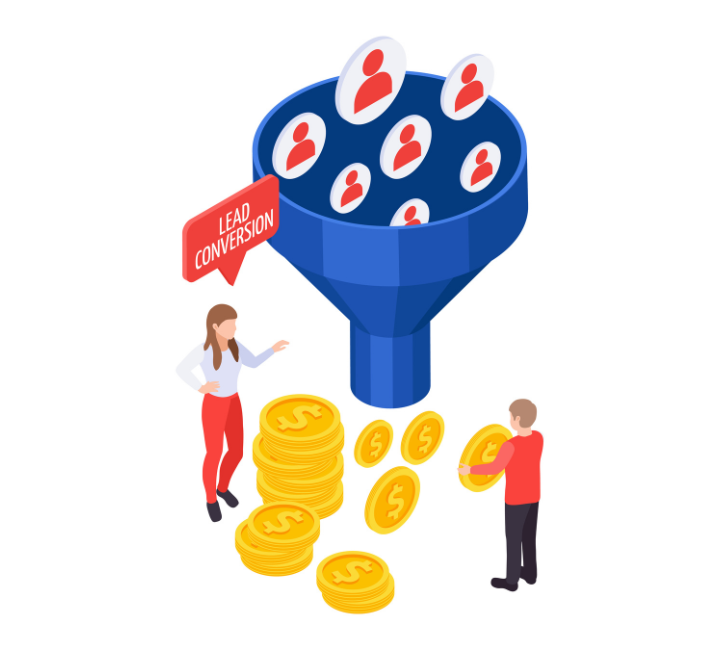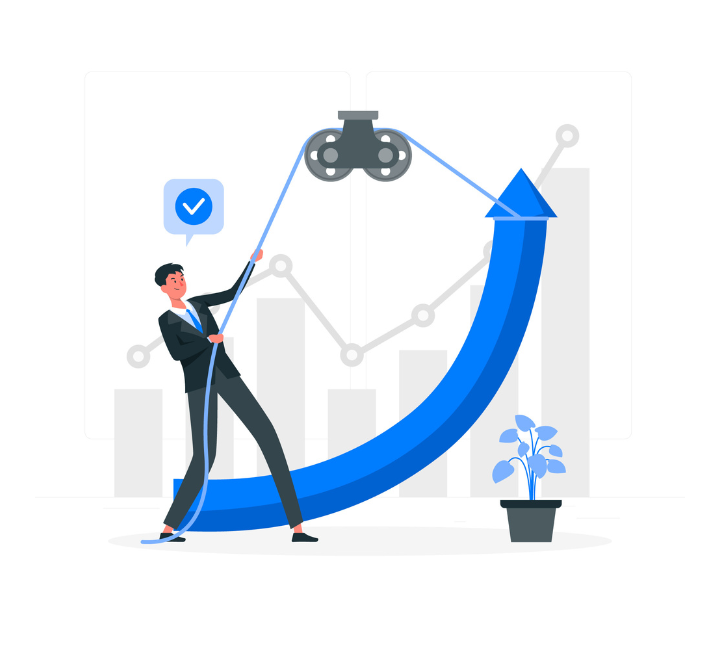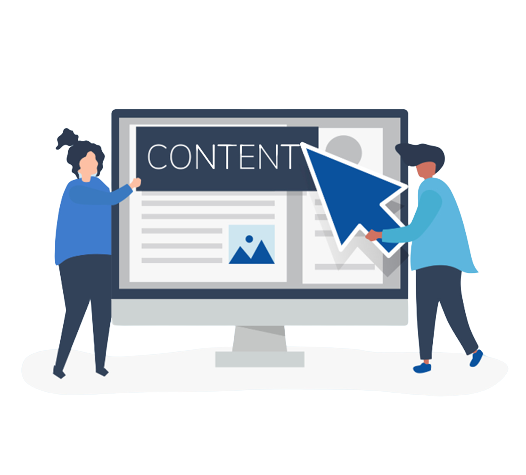Measuring the ROI of Your B2B Lead Generation Campaigns: Tools and Metrics to Watch

Introduction and Understanding ROI
In the world of B2B lead generation, success isn't just about gathering a list of potential clients. It's about something more concrete: Return on Investment (ROI). ROI is like the North Star guiding your B2B journey, ensuring that every effort you put in yields measurable results.
The Crucial Role of ROI in B2B Lead Generation
Imagine you're on a treasure hunt. You have limited time, resources, and energy. What would you rather chase after a chest of gold or an empty box? ROI is that chest of gold. It's the measure of how much you gain from your lead generation efforts compared to what you put in. In other words, it tells you if your treasure hunt is worth it.
For B2B lead generation, ROI is the lifeline. It's not just about collecting leads; it's about knowing that each lead is a step toward profitability. Without ROI, you're working in the dark, unsure if your strategies are effective or if you're throwing your resources into an abyss.
Understanding the Challenge: Why ROI Measurement Matters
Measuring ROI in B2B lead generation isn't always straightforward. B2B sales cycles can be long and complex, making it challenging to connect a single lead to a sale. But this challenge is precisely why ROI measurement matters.
Imagine you're a small business. You have a limited budget and every marketing dollar counts. You can't afford to invest in strategies that don't deliver results. You need to know what's working and what's not, so you can allocate your resources wisely.
Moreover, ROI measurement helps you fine-tune your strategies. It's like having a GPS for your B2B lead generation efforts. It tells you when to turn when to speed up, and when to take a different route. Without it, you might end up lost in the vast landscape of B2B marketing.
Overview of the Article's Focus on Tools and Metrics
This article is your guide to mastering ROI measurement in B2B lead generation. We'll break down the complex world of ROI into understandable concepts. We won't drown you in technical jargon or overwhelm you with data.
We'll explore the metrics that matter most, the tools that make measurement easier, and the practical tips that can significantly impact your ROI. Whether you're a seasoned marketer or just dipping your toes into B2B lead generation, we've got you covered.
Unpacking ROI in B2B Lead Generation (Explained)
Before we dive into the practical aspects of measuring ROI, let's start by demystifying what ROI means in the B2B context. In the next section, we'll define ROI without the jargon and clarify the difference between ROI and ROAS. We'll also explore why achieving ROI is the ultimate goal of any successful B2B lead generation campaign.
Defining ROI in the B2B Context (Without the Jargon)
ROI stands for Return on Investment. It's essentially a way to figure out if the money and effort you're putting into your lead-generation campaigns are paying off. In simpler terms, it's about knowing if you're getting more back than you're putting in.
Imagine you spend $1,000 on a targeted B2B email campaign. From that campaign, you generate $5,000 in revenue. Your ROI is ($5,000 - $1,000) / $1,000, which equals 4. In percentage terms, that's a 400% ROI. For every dollar you invested, you got four dollars in return.
ROI helps you determine the effectiveness of your marketing and sales efforts. It's a clear indicator of whether your strategies are delivering the results you want. As a small business, this information is gold because it tells you where to allocate your resources for maximum impact.
ROI vs. ROAS: What's the Difference?
ROI and ROAS (Return on Ad Spend) are related but slightly different concepts. ROI considers all the costs associated with your lead generation efforts, while ROAS focuses specifically on the return from your advertising spend. In other words, ROI gives you a broader view of your overall investment's effectiveness.
The Real Value of a Successful B2B Lead Generation Campaign
Ultimately, the goal of your B2B lead generation campaigns is not just to accumulate leads but to generate revenue. It's about turning those leads into paying customers, forging valuable relationships, and growing your business. ROI measurement is your compass on this journey, ensuring that every step you take brings you closer to your treasure chest of success.
Essential Metrics and Tools
When it comes to measuring the success of your B2B lead generation efforts, you don't need a complex spreadsheet filled with overwhelming details. In this section, we'll break down the essential metrics you should track without drowning you in data, and we'll introduce you to user-friendly tools that simplify the process.
The Essential Metrics to Track (Without the Overwhelming Details)
Conversion Rate: Turning Leads into Opportunities
Your conversion rate is the litmus test of your lead generation effectiveness. It tells you the percentage of website visitors who take the desired action, whether it's filling out a contact form, signing up for a newsletter, or requesting a demo. A higher conversion rate means you're turning more leads into valuable opportunities for your business.
Customer Acquisition Cost (CAC): How Much Are You Spending?
CAC measures the cost of acquiring a new customer. It factors in your marketing and sales expenses, helping you understand if your investment in lead generation is cost-effective. Lowering your CAC while maintaining quality is a surefire way to boost ROI.
Customer Lifetime Value (CLV): The Long-Term Perspective
CLV estimates the total revenue a customer is likely to generate throughout their relationship with your business. It's a crucial metric for B2B lead generation because it emphasizes the long-term value of acquiring quality leads. Focusing on high CLV leads ensures sustainable growth.
Marketing Qualified Leads (MQLs) vs. Sales Qualified Leads (SQLs)
To efficiently allocate resources, you need to distinguish between MQLs and SQLs. MQLs are potential leads showing interest, while SQLs are prospects that your sales team deems ready for conversion. By prioritizing SQLs, you optimize your sales efforts.
Website Traffic and Engagement: Beyond the Numbers
While website traffic is essential, it's equally important to assess user engagement. Metrics like time spent on your site, bounce rate, and page views per visit reveal how effectively your content engages visitors. Quality engagement often leads to better lead-generation outcomes.
Tools for Measuring ROI (Simplified)
Google Analytics: Your Window into Website Insights
Google Analytics is your trusty sidekick in the world of web analytics. It provides invaluable insights into website traffic, user behavior, and conversion data. With user-friendly dashboards and reports, it's a go-to tool for understanding how your leads interact with your site.
CRM Systems: Tracking Leads from Click to Close
Customer Relationship Management (CRM) systems like Salesforce or HubSpot help you track leads from their initial interaction with your brand to the final sale. They centralize customer data, streamline communication, and provide a holistic view of your lead generation efforts.
Marketing Automation: Streamlining Data for Better ROI Analysis
Marketing automation platforms like Marketo and Pardot simplify lead nurturing and data analysis. They automate repetitive tasks, segment your leads for personalized communication, and provide in-depth analytics to gauge ROI.
ROI Calculation Spreadsheets: Making It Easy for Small Businesses
For smaller businesses, a well-structured spreadsheet can do wonders. You can create a simplified ROI calculation sheet to track expenses, revenue, and ROI over time. It's a cost-effective way to get started on ROI analysis.
Lead Attribution Models: Who Gets Credit for the Conversion?
Attribution models help assign credit to the marketing channels and touchpoints that contributed to a lead's conversion. Whether it's first-touch, last-touch, or multi-touch attribution, these models demystify the customer journey and guide your lead generation strategy.
By focusing on these essential metrics and using these user-friendly tools, you'll gain valuable insights into the performance of your B2B lead generation campaigns without getting lost in the data maze.
Practical Tips and Challenges
In this section, we're diving into the practical side of optimizing ROI in B2B lead generation. We'll equip you with actionable tips to enhance your ROI and help you overcome common challenges that may arise along the way.
Practical Tips for Improving ROI (Actionable)
Optimizing Landing Pages for Higher Conversions
Your landing pages are the gateways to lead generation success. To boost ROI, ensure that your landing pages are designed for conversions. Simplify forms, craft compelling headlines, and use persuasive visuals. A streamlined, user-friendly experience can significantly impact your conversion rates.
Personalization: The ROI Booster You Can't Ignore
Personalization is the secret sauce for driving higher ROI. Tailor your content and messaging to specific audience segments. Address leads by their names, recommend relevant solutions and create personalized email campaigns. A personalized approach makes leads feel valued and increases conversion rates.
A/B Testing: Small Changes, Big Impact
A/B testing is your toolkit for continuous improvement. Experiment with different elements of your campaigns, such as email subject lines, CTAs, or landing page layouts. By systematically testing variations, you can identify what resonates most with your audience and optimize for maximum ROI.
Lead Nurturing: Turning Cold Leads into Profitable Customers
Not all leads are ready to convert immediately. Implement a lead nurturing strategy to cultivate relationships over time. Provide valuable content, share industry insights, and address pain points. Gradually warming up leads can turn them into profitable customers in the long run.
Budget Allocation: Where to Invest for Maximum ROI
Smart budget allocation is key to maximizing ROI. Analyze which channels and campaigns deliver the best results. Shift resources towards high-performing strategies while optimizing or phasing out underperforming ones. This dynamic approach ensures your budget is working harder for you.
Challenges in ROI Measurement and How to Tackle Them (Practical Advice)
The Attribution Challenge: Who Gets Credit for the Sale?
Attribution can be a puzzle. Leads interact with multiple touchpoints before converting, making it difficult to determine which channel or interaction deserves credit. Utilize multi-touch attribution models to fairly distribute credit and gain a more accurate picture of ROI contributors.
Dealing with Incomplete Data: Making Informed Decisions Anyway
Incomplete data is a common challenge, especially when dealing with complex B2B sales cycles. Don't let gaps in data deter you. Use available data and apply statistical techniques to fill in the blanks. An informed decision based on partial data is often better than no decision at all.
Aligning Sales and Marketing Teams for Better ROI Tracking
The disconnect between sales and marketing teams can hinder ROI tracking. Foster alignment by defining shared goals, establishing clear communication channels, and implementing a unified CRM system. When both teams work together seamlessly, tracking ROI becomes more accurate and efficient.
Navigating the practical aspects of improving ROI and overcoming challenges is essential for any B2B lead generation campaign. By implementing these actionable tips and addressing common hurdles, you'll be well on your way to optimizing your ROI effectively.
Future Trends and Conclusion
As we wrap up our journey through the world of B2B lead generation ROI, we'll explore what lies on the horizon and offer closing thoughts to empower your future endeavors.
Future Trends in ROI Measurement (Looking Ahead, Not Over the Horizon)
The Role of AI and Predictive Analytics
The future of ROI measurement in B2B lead generation is intertwined with Artificial Intelligence (AI) and predictive analytics. AI-powered tools will provide deeper insights into lead behavior, allowing for more accurate predictions of conversion likelihood. This means you'll be able to focus your efforts where they matter most, maximizing ROI.
Privacy Concerns: How They Might Impact ROI Measurement
With evolving privacy regulations and consumer awareness, there will be growing concerns about data collection and usage. This will impact how businesses track ROI. Expect an increased emphasis on ethical data handling, consent-driven tracking, and transparent ROI measurement practices. Being privacy-conscious will be crucial for maintaining trust and compliance.
The Growing Emphasis on Customer Experience and Its Influence on ROI
Customer experience (CX) will take center stage in ROI measurement. Happy customers are more likely to become loyal advocates, contributing significantly to long-term ROI. Measuring CX-related metrics, such as Net Promoter Score (NPS) and Customer Satisfaction (CSAT), will become essential in understanding how lead generation impacts overall ROI.
Conclusion
In closing, we encourage you to take action today and start measuring ROI in your B2B lead generation efforts. ROI isn't just a metric; it's a compass guiding you toward greater efficiency, profitability, and growth. Remember these final thoughts as you embark on your ROI measurement journey:
ROI Is Within Reach: ROI measurement might seem daunting, but with the right tools and knowledge, it's entirely achievable. Don't shy away from it; embrace it as a powerful ally.
Continuous Improvement: ROI measurement isn't a one-time task. It's an ongoing process of improvement. As you track, analyze, and optimize, you'll uncover new opportunities for growth.
Adapt to the Future: Keep an eye on emerging trends in ROI measurement. Embrace AI, navigate privacy concerns ethically, and prioritize customer experience. These are the pillars of future success.
Empower Your Business: Effective ROI measurement empowers your business to make data-driven decisions. It ensures that your resources are allocated wisely, resulting in a thriving B2B lead generation ecosystem.
We hope this journey through the world of B2B lead generation ROI has provided you with valuable insights and actionable strategies. Now, armed with the knowledge and tools, go forth and master ROI in your B2B lead generation efforts. Your path to success is illuminated by the ROI you measure today.
Related Articles
Say Hello to iSyndicate Ecosystem

Data Cloud
138+ million contacts that are ready to hear from you.

Email automation
That captures prospects intent actions.

Publishing network
That syndicates your content on 300+ B2B websites

AI voice bot
That communicate with prospects efficiently







